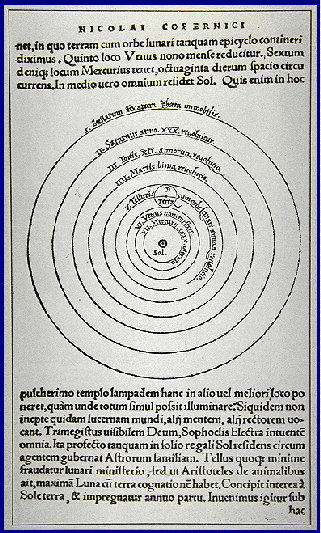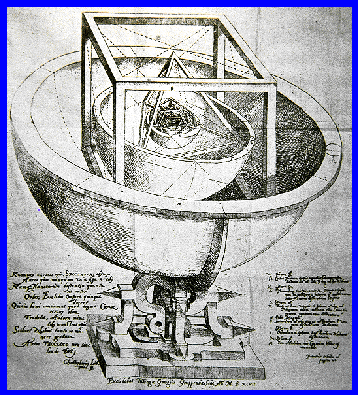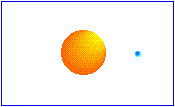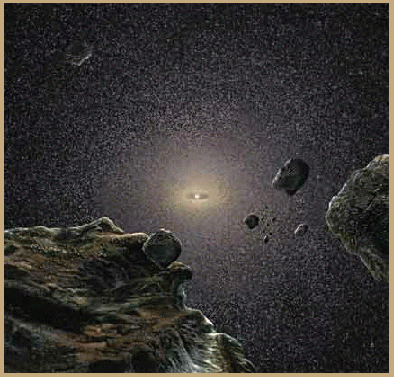 Lesson 1:
Lesson 1:
 Ecology of the System
Ecology of the System
|
 1.1
1.1
 Discovery of the Solar System
Discovery of the Solar System
Questions about the origin of Life in the solar system could only be asked after it was
realized that there is a solar system and that living organisms evolve through time.
Both discoveries are relatively recent, as far as human history goes. One has now been
generally accepted that is, that Earth and the other planets revolve around the Sun
("heliocentric system"). The other, while scientifically equally unassailable, still
struggles for acceptance in many cultures of the world ("evolution").
The discovery of the solar system belongs to the period called the "Renaissance", when
philosophers decided to admit nothing but observation and logic in building the science
enterprise, and to reject tradition. Perhaps the best-known exponent of this new (and
courageous) approach is the French mathematician, philosopher and scientist Rene Descartes
(1596-1650). His statement "cogito ergo sum" (I think therefore I am) is symbolic for the
Renaissance attitude. (Some have pointed out that you can't just think without thinking of
something, so that it is impossible to start science with pure logic. Anyway, Descartes
tried it and came up with lots of interesting results, and some pretty strange notions,
too.)
The discovery that living things evolve came much later, in the 19th century. Even today,
some people are not reconciled to the fact that life evolves. General acceptance of the
sun-centered system of celestial motions took several hundred years. Why should general
acceptance of evolution move any faster?

|

Figure 1.1.1 The Copernican System
Click on image for larger view.
|
The main idea of the solar system was proposed by the Polish astronomer
Nicolaus Copernicus (1473-1543) who said that "the Sun is the center of
the Universe" and made the planets move around it in perfect circles
("On the Revolution of the Celestial Spheres", in Latin, published in
1543). He thereby revived an ancient idea going back to the Greek
philosopher Aristarchos (flourished ~270 B.C.) who suggested that the
Sun is much bigger than the Earth and that it, and not the Earth, is at
the center of the universe. (Nobody paid much attention to this, since
it is plain that the Sun is moving around a lot: once a day across the
sky, once a year across the stars at different elevations above the
horizon.)

|

Figure 1.1.2 Kepler's model of the solar system.
Click on image for larger view.
|
The German astronomer Johannes Kepler (1571-1630) supported the
Copernican concept that the Sun is at the center, but gave to the
planets elliptical orbits, with the Sun in one of the foci of each
ellipse, to describe their complicated motions more correctly. The
direct observations by Galileo Galilei (1564-1642), who showed that
Venus has phases like the moon (using the telescope he invented and
built) clinched the matter for the heliocentric system.

|

|

Figure 1.1.3 Galileo's telescopes.
|
(The Church disagreed. It put Copernicus' book on the index of forbidden works in
1616, and left it there till 1835. Also, Galileo had to recant and was
forbidden to teach and to leave his home.) Galileo was one of the great
minds of all time. As the French philospher Yves Bonnefoy has said:
"With Galileo, the Moon ceased to be an object of adoration and became
an object for scientific study." Another Italian astronomer, Giovanni
Domenico Cassini (1625-1721) (whose name is associated with the large
gap between the inner and outer rings of Saturn) determined the size of
Earth's orbit. His value was only 7 percent short of the modern one (150
million km). He established the size of the solar system. (Aristarchus
had been off by a factor of 20 in estimating the distance to the Sun.)

|
Figure 1.1.4 Planetary motion as described by Newton's Laws.
|
Then came Isaac Newton (1642-1727) who brought the laws of physics to
the solar system. Isaac Newton explained why the planets move the way
they do, by applying his laws of motion, and the force of gravitation
between any two bodies, letting the force decrease with the square of
the distance between the two bodies. (Besides formulating the laws of
motion, Newton invented the concept of gravitational force and a new
kind of math to calculate planetary motions. The math is now called
calculus. It was invented independently, and published earlier, by the
German mathematician Gottfried Wilhelm Leibniz (1646-1716) whose
notation is still used in textbooks today. Newton also built the first
reflecting telescope to survey the sky with.)
Knowing that the Sun is in the center of the system, and the rotating
planets move around it in their proper orbits following Newton's laws
became the basis for further exploration of "celestial mechanics". Many
details of the motions remained to be worked out. Major contributions
came from the French mathematicians and astronomers Pierre Simon de
Laplace (1749-1827), Joseph Louis Lagrange (1736-1813), and Urbain
Leverrier (1811-1877). (Even now celestial mechanics is an active field
of study, because of the amount of computation it takes to work out
planetary positions for millions of years.)

|

Figure 1.1.5 Comet Halley
|
The English astronomer Edmund Halley (1656-1742) realized that comets
are part of the system (at least one of them, Halley's Comet, kept on
coming back every 75 years). Neptun, a major planet, was only discovered
in 1846 (by the German astronomer Johann Galle, following instructions
from Leverrier); Pluto was found in 1930. Many astronomers now think
Pluto is really just an unusually big comet-type body (or rather two
bodies) in the "Kuiper Belt", with hundreds or thousands such bodies.
The Kuiper Belt takes its name from the Dutch-American astronomer Gerard
Kuiper (1905-1973) who made many contributions to the knowledge of
satellites of the outer planets.
In addition, there is the "Oort Cloud", asteroids and comets that
surround the solar system like a swarm of mosquitoes surrounds a group
of people on a picnic in summer, in Minnesota. The "Oort Cloud", named
after the Dutch astronomer Jan Hendrik Oort (1900-1992) who proposed its
existence (in 1950), is an enormous assemblage of comets at great
distance from the inner solar system. It serves as a seemingly
inexhaustible reservoir for comets coming close to the Sun (and
therefore becoming short-lived). Comets that cross the path of the inner
planets do so, it is thought, because their orbits were disturbed by the
gravitational influence from passing stars.

|

Figure 1.1.6 Artist's rendition of the Oort Cloud.
|
|





















